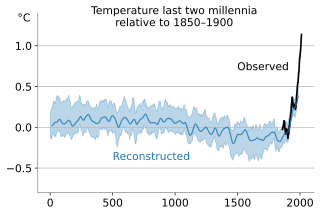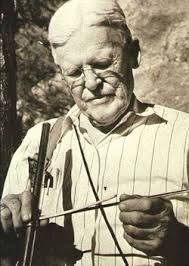Related Research Articles

Climate is the long-term weather pattern in a region, typically averaged over 30 years. More rigorously, it is the mean and variability of meteorological variables over a time spanning from months to millions of years. Some of the meteorological variables that are commonly measured are temperature, humidity, atmospheric pressure, wind, and precipitation. In a broader sense, climate is the state of the components of the climate system, including the atmosphere, hydrosphere, cryosphere, lithosphere and biosphere and the interactions between them. The climate of a location is affected by its latitude, longitude, terrain, altitude, land use and nearby water bodies and their currents.

Dendrochronology is the scientific method of dating tree rings to the exact year they were formed in a tree. As well as dating them, this can give data for dendroclimatology, the study of climate and atmospheric conditions during different periods in history from the wood of old trees. Dendrochronology derives from the Ancient Greek dendron, meaning "tree", khronos, meaning "time", and -logia, "the study of".

Paleoclimatology is the scientific study of climates predating the invention of meteorological instruments, when no direct measurement data were available. As instrumental records only span a tiny part of Earth's history, the reconstruction of ancient climate is important to understand natural variation and the evolution of the current climate.

In the study of past climates ("paleoclimatology"), climate proxies are preserved physical characteristics of the past that stand in for direct meteorological measurements and enable scientists to reconstruct the climatic conditions over a longer fraction of the Earth's history. Reliable global records of climate only began in the 1880s, and proxies provide the only means for scientists to determine climatic patterns before record-keeping began.
The National Oceanographic Data Center (NODC) was one of the national environmental data centers operated by the National Oceanic and Atmospheric Administration (NOAA) of the U.S. Department of Commerce. The main NODC facility was located in Silver Spring, Maryland, and consisted of five divisions. The NODC also had field offices collocated with major government or academic oceanographic laboratories in Stennis Space Center, MS; Miami, FL; La Jolla, San Diego, California; Seattle, WA; Austin, Texas; Charleston, South Carolina; Norfolk, Virginia; and Honolulu, Hawaii. In 2015, NODC was merged with the National Climatic Data Center and the National Geophysical Data Center into the National Centers for Environmental Information (NCEI).

The Byrd Polar and Climate Research Center (BPCRC) is a polar, alpine, and climate research center at Ohio State University founded in 1960.
Dendroclimatology is the science of determining past climates from trees. Tree rings are wider when conditions favor growth, narrower when times are difficult. Other properties of the annual rings, such as maximum latewood density (MXD) have been shown to be better proxies than simple ring width. Using tree rings, scientists have estimated many local climates for hundreds to thousands of years previous. By combining multiple tree-ring studies, scientists have estimated past regional and global climates.

The global temperature record shows the fluctuations of the temperature of the atmosphere and the oceans through various spans of time. There are numerous estimates of temperatures since the end of the Pleistocene glaciation, particularly during the current Holocene epoch. Some temperature information is available through geologic evidence, going back millions of years. More recently, information from ice cores covers the period from 800,000 years before the present time until now. A study of the paleoclimate covers the time period from 12,000 years ago to the present. Tree rings and measurements from ice cores can give evidence about the global temperature from 1,000-2,000 years before the present until now. The most detailed information exists since 1850, when methodical thermometer-based records began. Modifications on the Stevenson-type screen were made for uniform instrument measurements around 1880.

Dendroarchaeology is a term used for the study of vegetation remains, old buildings, artifacts, furniture, art and musical instruments using the techniques of dendrochronology. It refers to dendrochronological research of wood from the past regardless of its current physical context. This form of dating is the most accurate and precise absolute dating method available to archaeologists, as the last ring that grew is the first year the tree could have been incorporated into an archaeological structure.
Thomas W. Swetnam is Regents' Professor Emeritus of Dendrochronology at the University of Arizona, studying disturbances of forest ecosystems across temporal and spatial scales. He served as the Director of the Laboratory of Tree-Ring Research from 2000 to 2015.
Malcolm K. Hughes is a meso-climatologist and Regents' Professor of Dendrochronology in the Laboratory for Tree-Ring Research at the University of Arizona.

The divergence problem is an anomaly from the field of dendroclimatology, the study of past climate through observations of old trees, primarily the properties of their annual growth rings. It is the disagreement between instrumental temperatures and the temperatures reconstructed from latewood densities or, in some cases, from the widths of tree rings in far northern forests.

A. E. Douglass was an American astronomer. He discovered a correlation between tree rings and the sunspot cycle, and founded the discipline of dendrochronology, which is a method of dating wood by analyzing the growth ring pattern. He started his discoveries in this field in 1894 when he was working at the Lowell Observatory. During this time he was an assistant to Percival Lowell, but fell out with him when his experiments made him doubt the existence of artificial "canals" on Mars and visible spokes on Venus.
Cretaceous polar forests were temperate forests that grew at polar latitudes during the final period of the Mesozoic Era, known as the Cretaceous Period 145–66 Ma. During this period, global average temperature was about 10 °C (18 °F) higher and carbon dioxide (CO2) levels were approximately 1000 parts per million (ppm), 2.5 times the current concentration in Earth's atmosphere. The abundance of atmospheric carbon dioxide had a very significant impact on global climate and Earth's natural systems as its concentration is considered one of the main factors in the development of a pronounced greenhouse Earth during the Cretaceous, with a very low average global temperature gradient. As a consequence, high paleolatitudes in both hemispheres were much warmer than at present. This temperature gradient was partly responsible for the lack of continental ice sheets in polar regions.
Trees have a wide variety of sizes and shapes and growth habits. Specimens may grow as individual trunks, multitrunk masses, coppices, clonal colonies, or even more exotic tree complexes. Most champion tree programs focus finding and measuring the largest single-trunk example of each species. There are three basic parameters commonly measured to characterize the size of a single trunk tree: tree height measurement, tree girth measurement, and tree crown measurement. Foresters also perform tree volume measurements. A detailed guideline to these basic measurements is provided in The Tree Measuring Guidelines of the Eastern Native Tree Society by Will Blozan.

Lisa J. Graumlich is an American paleoclimatologist who studies the interactions between the climate, ecosystems and humans. She is the inaugural dean of College of the Environment at the University of Washington. Graumlich is a Fellow of the American Association for the Advancement of Science and the Ecological Society of America, and is president-elect of the American Geophysical Union.

Little Ice Age volcanism refers to the massive volcanic activities during the Little Ice Age. Scientists suggested a hypothesis that volcanism was the major driving force of the global cooling among the other natural factors, i.e. the sunspot activities by orbital forcing and greenhouse gas. The Past Global Change (PAGES), a registered paleo-science association for scientific research and networking on past global changes in the University of Bern, Switzerland, suggested that from 1630 to 1850, a total of 16 major eruptions and cooling events had taken place. When a volcano erupts, ashes burst out of the vent together with magma and forms a cloud in the atmosphere. The ashes act as an isolating layer that block out a proportion of solar radiation, causing global cooling. The global cooling effect impacts ocean currents, atmospheric circulation and cause social impacts such as drought and famine. Wars and rebellions were therefore triggered worldwide in the Little Ice Age. It was suggested that the crisis on Ottoman Empire and Ming-Qing Transition in China were typical examples that closely correlated with Little Ice Age.
Rosanne D'Arrigo is a professor at Lamont–Doherty Earth Observatory at Columbia University known for her research into climate change using dendrochronology, or dating based on tree rings.
Aster Afwork GebrekirstosFAASTWAS is an Ethiopian scientist and a professor of agroforestry at World Agroforestry Centre (ICRAF).
References
- ↑ "National Centers for Environmental Information -- Tree Ring". NOAA. Retrieved 11 April 2022.
- ↑ "Cash shortage threatens tree-ring lab". New Scientist. 89 (1241): 462. February 1981.
- ↑ Speer, James H. (2010). Fundamentals of Tree-ring Research. University of Arizona Press. p. 41. ISBN 978-0-8165-2684-0.
- ↑ Fritts, H.C. (1976). "The Statistics of Ring-Width and Climatic Data". Tree Rings and Climate. pp. 246–311. doi:10.1016/B978-0-12-268450-0.50011-2. ISBN 978-0-12-268450-0. OCLC 645882099.
- ↑ "Old Wood in a New Light: An Online Dendrochronological Database". International Journal of Wood Culture. 3 (2023): 442–463. 2023-05-16. doi:10.1163/27723194-bja10009. ISSN 2772-3186.
- ↑ Hughes, Malcolm (23 February 1978). "European tree rings and climate". New Scientist. 77 (1091): 500–502.